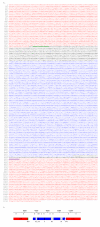Diaspora, a large family of Ty3-gypsy retrotransposons in Glycine max, is an envelope-less member of an endogenous plant retrovirus lineage
- PMID: 15876351
- PMCID: PMC1142308
- DOI: 10.1186/1471-2148-5-30
Diaspora, a large family of Ty3-gypsy retrotransposons in Glycine max, is an envelope-less member of an endogenous plant retrovirus lineage
Abstract
Background: The chromosomes of higher plants are littered with retrotransposons that, in many cases, constitute as much as 80% of plant genomes. Long terminal repeat retrotransposons have been especially successful colonizers of the chromosomes of higher plants and examinations of their function, evolution, and dispersal are essential to understanding the evolution of eukaryotic genomes. In soybean, several families of retrotransposons have been identified, including at least two that, by virtue of the presence of an envelope-like gene, may constitute endogenous retroviruses. However, most elements are highly degenerate and are often sequestered in regions of the genome that sequencing projects initially shun. In addition, finding potentially functional copies from genomic DNA is rare. This study provides a mechanism to surmount these issues to generate a consensus sequence that can then be functionally and phylogenetically evaluated.
Results: Diaspora is a multicopy member of the Ty3-gypsy-like family of LTR retrotransposons and comprises at least 0.5% of the soybean genome. Although the Diaspora family is highly degenerate, and with the exception of this report, is not represented in the Genbank nr database, a full-length consensus sequence was generated from short overlapping sequences using a combination of experimental and in silico methods. Diaspora is 11,737 bp in length and contains a single 1892-codon ORF that encodes a gag-pol polyprotein. Phylogenetic analysis indicates that it is closely related to Athila and Calypso retroelements from Arabidopsis and soybean, respectively. These in turn form the framework of an endogenous retrovirus lineage whose members possess an envelope-like gene. Diaspora appears to lack any trace of this coding region.
Conclusion: A combination of empirical sequencing and retrieval of unannotated Genome Survey Sequence database entries was successfully used to construct a full-length representative of the Diaspora family in Glycine max. Diaspora is presently the only fully characterized member of a lineage of putative plant endogenous retroviruses that contains virtually no trace of an extra coding region. The loss of an envelope-like coding domain suggests that non-infectious retrotransposons could swiftly evolve from infectious retroviruses, possibly by anomalous splicing of genomic RNA.
Figures






Similar articles
-
Potential retroviruses in plants: Tat1 is related to a group of Arabidopsis thaliana Ty3/gypsy retrotransposons that encode envelope-like proteins.Genetics. 1998 Jun;149(2):703-15. doi: 10.1093/genetics/149.2.703. Genetics. 1998. PMID: 9611185 Free PMC article.
-
Athila4 of Arabidopsis and Calypso of soybean define a lineage of endogenous plant retroviruses.Genome Res. 2002 Jan;12(1):122-31. doi: 10.1101/gr.196001. Genome Res. 2002. PMID: 11779837 Free PMC article.
-
SIRE1, an endogenous retrovirus family from Glycine max, is highly homogeneous and evolutionarily young.Mol Biol Evol. 2003 Aug;20(8):1222-30. doi: 10.1093/molbev/msg142. Epub 2003 May 30. Mol Biol Evol. 2003. PMID: 12777503
-
Identification and analysis of gene families from the duplicated genome of soybean using EST sequences.BMC Genomics. 2006 Aug 9;7:204. doi: 10.1186/1471-2164-7-204. BMC Genomics. 2006. PMID: 16899135 Free PMC article. Review.
-
LINEs, SINEs and repetitive DNA: non-LTR retrotransposons in plant genomes.Plant Mol Biol. 1999 Aug;40(6):903-10. doi: 10.1023/a:1006212929794. Plant Mol Biol. 1999. PMID: 10527415 Review.
Cited by
-
FIDEL-a retrovirus-like retrotransposon and its distinct evolutionary histories in the A- and B-genome components of cultivated peanut.Chromosome Res. 2010 Feb;18(2):227-46. doi: 10.1007/s10577-009-9109-z. Epub 2010 Feb 2. Chromosome Res. 2010. PMID: 20127167 Free PMC article.
-
Presence of env-like sequences in Quercus suber retrotransposons.J Appl Genet. 2010;51(4):461-7. doi: 10.1007/BF03208875. J Appl Genet. 2010. PMID: 21063063
-
SoyTEdb: a comprehensive database of transposable elements in the soybean genome.BMC Genomics. 2010 Feb 17;11:113. doi: 10.1186/1471-2164-11-113. BMC Genomics. 2010. PMID: 20163715 Free PMC article.
-
Functional centromeres in soybean include two distinct tandem repeats and a retrotransposon.Chromosome Res. 2010 Apr;18(3):337-47. doi: 10.1007/s10577-010-9119-x. Epub 2010 Mar 5. Chromosome Res. 2010. PMID: 20204495
-
A widespread occurrence of extra open reading frames in plant Ty3/gypsy retrotransposons.Genetica. 2011 Dec;139(11-12):1543-55. doi: 10.1007/s10709-012-9654-9. Epub 2012 Apr 29. Genetica. 2011. PMID: 22544262
References
-
- Deininger PL, Roy-Engel AM. Mobile Elements in Animal and Plant Genomes. In: Craig NL, Craigie R, Gellert M and Lambowitz AM, editor. Mobile DNA II. Washington, D.C., ASM Press; 2002. pp. 1074–1092.
-
- Eickbush TH, Malik HS. Origins and Evolution of Retrotransposons. In: Craig NL, Craigie R, Gellert M and Lambowitz AM, editor. Mobile DNA II. Washington, D.C., ASM Press; 2002. pp. 1111–1144.
Publication types
MeSH terms
Substances
LinkOut - more resources
Full Text Sources
Other Literature Sources

